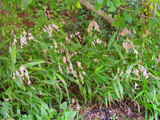Native Plants

Q. Who is Mr. Smarty Plants?
A: There are those who suspect Wildflower Center volunteers are the culpable and capable culprits. Yet, others think staff members play some, albeit small, role. You can torture us with your plant questions, but we will never reveal the Green Guru's secret identity.
Did you know you can access the Native Plant Information Network with your web-enabled smartphone?
Ask Mr. Smarty Plants is a free service provided by the staff and volunteers at the Lady Bird Johnson Wildflower Center.

rate this answer
Monday - May 04, 2009
From: Blairsville, GA
Region: Southeast
Topic: Groundcovers
Title: Groundcover for steep hill in Georgia
Answered by: Nan Hampton
QUESTION:
We have a large steep hill with only clay and rocks on it in the North Georgia Mountain area. What is a good Native ground covering to put on this for erosion? Something that grows fast preferably. We do not want grass.ANSWER:
Mr. Smarty Plants is sorry you won't consider some grass in the erosion area. Native grasses are an excellent choice for controlling erosion because they develop extensive fibrous root systems that hold the soil in place. Depending on how steep your hill is and the extent of erosion, you might want to consider using a erosion-control blanket to stabilize the erosion area so that the seeds can get a better chance to germinate and become established. The erosion-control fabric works by slowing the runoff water and allowing sediment to fall out rather than be washed away. Seeds are sown under the erosion-control material and grow up through the matting when they germinate. Underneath the matting the roots of the plants growing through the erosion-control material anchor the soil to stop the erosion. If you use erosion-control blankets made of biodegrable material, they will eventually disappear leaving the plants to control the problem. Seeds can be sown under an erosion control blanket or grass plugs or other plants can be planted through the blanket. Here are some low-growing plants (generally less than 3 feet) that are known to grow in Union County, Georgia, or in adjacent counties:GROUNDCOVER:
Artemisia ludoviciana (white sagebrush)
Chimaphila maculata (striped prince's pine)
Chamaecrista nictitans ssp. nictitans (sensitive partridge pea)
Comandra umbellata (bastard toadflax)
Hypericum buckleii (Buckley's St. Johnswort)
FERNS:
Dryopteris marginalis (marginal woodfern)
Osmunda cinnamomea (cinnamon fern)
Pteridium aquilinum (western brackenfern)
SHRUBS:
Ceanothus americanus (New Jersey tea)
Epigaea repens (trailing arbutus)
Gaultheria procumbens (eastern teaberry)
Hypericum hypericoides ssp. hypericoides (St. Andrew's cross)
Hypericum prolificum (shrubby St. Johnswort)
GRASS/GRASS-LIKE (in case you change your mind):
Aristida stricta (pineland threeawn)
Carex pensylvanica (Pennsylvania sedge)
Chasmanthium latifolium (Inland sea oats)
Eragrostis spectabilis (purple lovegrass)
Muhlenbergia schreberi (nimblewill)
More Groundcovers Questions
Groundcover for shade in Duval County, Florida
September 17, 2014 - What low growing ground cover would be good for a lake edge area. This area is shaded with overlying woodland type trees. I planted some autumn ferns but they have getting overrun with poison ivy. I a...
view the full question and answer
Planting Garry Oak in Kinnikinnick in WA
May 09, 2015 - I want to plant a Garry Oak tree in my backyard in an area currently covered in kinnikinnick planted by the previous homeowner. The kinnikinnick covers a large area - about 10 feet in diameter. Even...
view the full question and answer
Ground cover for Central California from Concord CA
July 19, 2012 - I live in a part of California where the summers can be very hot and dry but quite cool and wet during the rainy seasons in the wintertime. The soil around my home is very dry, rocky and infertile. I...
view the full question and answer
Filler for between flagstones in Michigan
July 05, 2014 - I have a natural shoreline project underway (replacing a seawall) with all native Michigan plants replacing the lawn as well. A flagstone walkway is going in and I wanted "moss" type filler in betw...
view the full question and answer
Evergreen for sunny, dry area under a maple in Connecticut
October 10, 2015 - I have a sloped, very sunny, dry area under a maple. I was wondering if Sweet Fern would be a likely candidate for this area. I would like it to
be evergreen and to be able to survive under mounds of...
view the full question and answer
| Support the Wildflower Center by Donating Online or Becoming a Member today. |

